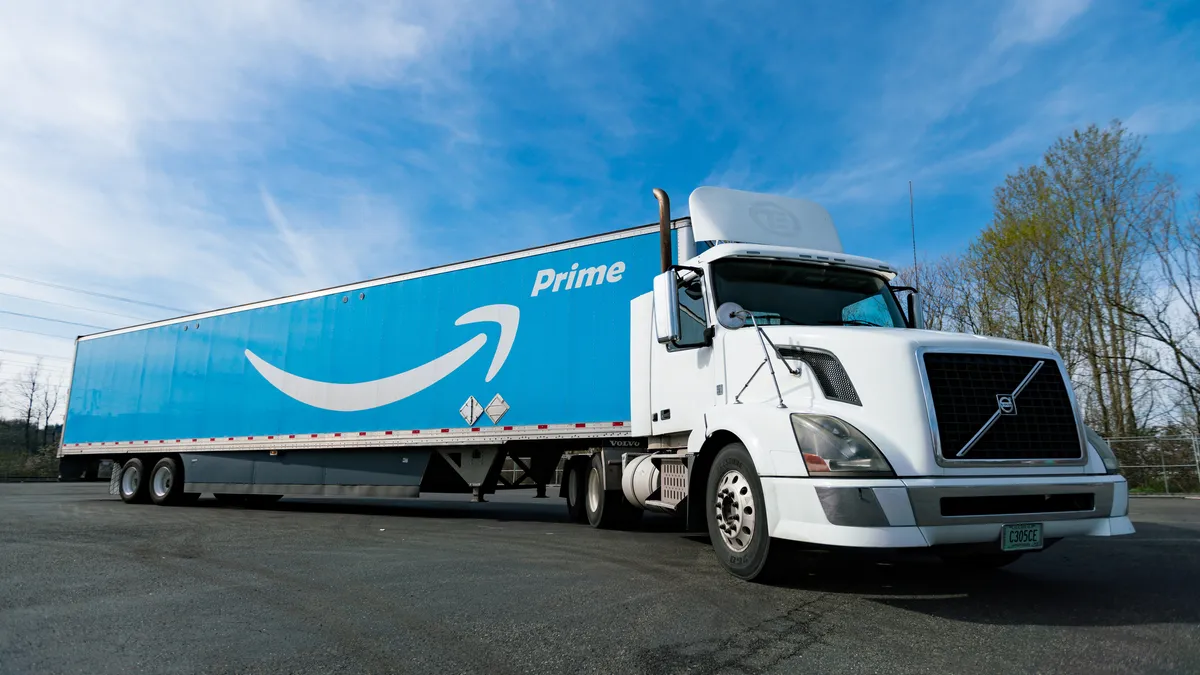Dive Brief:
- Amazon expanded it's newest fulfillment option — called Amazon Day — to all Prime members Thursday after a successful pilot with select members. The program allows members to choose a day of the week as their designated delivery day, meaning any orders they place throughout the week will be delivered on that day. Amazon Prime shipping options are still available for items that consumers want delivered more quickly.
- Amazon Day is also part of the company's "Shipment Zero" initiative to reach 50% net-zero carbon shipments by 2030, since the program has the potential to reduce the number of shipments Prime members receive regardless of the volume of purchases.
- "We’ve been testing this program with a group of Prime members and Amazon Day has already reduced packaging by tens of thousands of boxes – a number that will only continue to grow now that the program is available to Prime members nationwide," Maria Renz, vice president of delivery experience at Amazon, said in a statement.
Dive Insight:
This latest move from Amazon indeed has the benefit of potentially reducing the carbon footprint of the e-commerce culture that Amazon Prime debatably created. But Amazon Day has major operational benefits too, as it doubles down on customer convenience with the valuable operational plus of longer fulfillment times.
This quasi-negotiation between speed, convenience, waste and a longer fulfillment time horizon is the next evolution of retail fulfillment, according to Tom Enright, vice president of retail supply chain research at Gartner.
"The new question is: How long am I prepared to wait if I can secure a price reduction or some sort of incentive and still get the product, but more on my terms and perhaps more advantageously for the retailer," Enright said at The Retail Industry Leaders Association's LINK2019 conference.
Customers want convenience and certainty, but that doesn't always mean as fast as possible. Retailers that can figure out how to navigate that negotiation with the customer can derive great supply chain savings, Enright said.
In order to commit to two-day shipping, he explained, retailers have been scrambling to find optimal warehouse space or other fulfillment capacities. But if customers picked a delivery date four days from order, for example, all of a sudden that order can be fulfilled from a facility farther away, opening up the opportunity for inventory balancing efficiency too — along with a customer that's just as happy.
"One of the areas that consumers get frustrated with is this long, wide range of delivery opportunities — four to seven days. Well if day four is Thursday and day seven is early next week and I really want this item for the weekend, then I'm almost forced to pay for expedited shipping at a cost. What consumer really wants is the assuredness of saying 'it's going to arrive on this day,'" Enright said. "Amazon Day helps them deliver on that."
Amazon Day also responds to consumer concerns about environmental impact, which have grown as e-commerce has infiltrated daily life: "sustainability, excess packaging ... it feels bad inside," Enright said. In fact, this is perhaps the main customer "incentive" in the Amazon Day scheme.
Consumers are aware that receiving multiple packages per week from the same shipper, and often in larger than necessary boxes, is wasteful and detrimental to the environment, but the option of not ordering items online is a step too far for many. In fact, roughly 60-70% of consumers are factoring sustainability into their choice retailer, according to Enright.
"Some of this can be solvable by looking at a slower method of fulfillment," he said.













